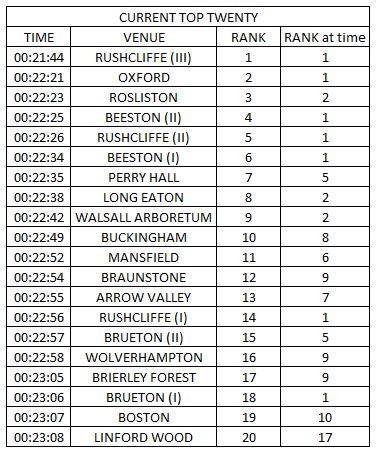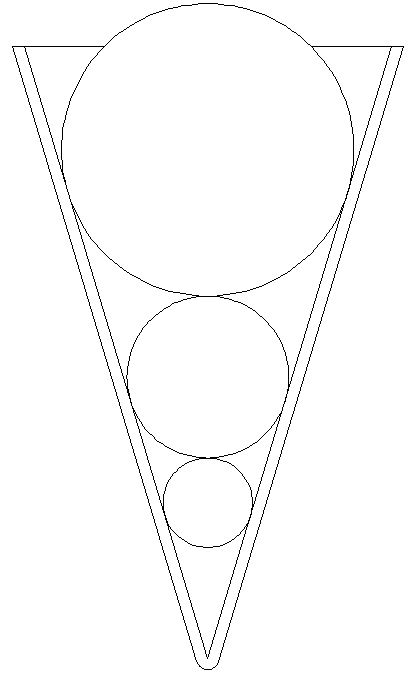Arrange these 15 ‘triples’ into 5 related words of 9 letters each:
BUR, CAM, CES, EMB, EMM, ENT, ERT, GER, HAL, LEI, LIM, ORT, ROQ, TER, UEF.
Your Custom Text Here
Arrange these 15 ‘triples’ into 5 related words of 9 letters each:
BUR, CAM, CES, EMB, EMM, ENT, ERT, GER, HAL, LEI, LIM, ORT, ROQ, TER, UEF.
What is 5 to the power of 55, minus 5, expressed in base 5?

Fit five cuboids into a sphere of radius 1.
What is the greatest combined volume you can achieve?
Similarly to the Three Rectangles in a Circle puzzle a couple of weeks ago, you’ll find that a great deal of symmetry will help to maximize the volume. Again of course, the answer is not an integer, so I'll be happy to accept an answer to one decimal place.
Good luck!
Which of these words is the odd one out?
APPLY GRANGE PARROT PEAK PLUG REACH
Notoriously, with odd-one-out questions, you will probably be able to find a reason why each of the words in turn should be the odd one. However, the true solution will be both convincing and satisfying, with even my choice of the odd word serving to support your hypothesis. Good luck!
Here’s a little gift for you: an excel version of my Binary Determination puzzle.
Just stick it on your desktop and have a play if you ever get bored, or play it first thing in the morning to wake your brain up.
It will randomly generate one of a possible 100 billion billion billion puzzles (which is a lot more than the age of the universe in seconds). When you have completed a row or column the target number will turn green.
I’ve included macros to clear the board (but leave the target numbers as they are), or to begin a completely new game. You will need to enable macros and iterative calculation (circular references). I’ve protected the worksheet to prevent you from inadvertently changing cells that don’t need to be changed, but it’s not password protected so if you want to take a peek under the hood you are perfectly welcome!
You can download the .xlsm file from my Dropbox by following this link:
https://www.dropbox.com/s/qm9uzju27mritcx/binary%20determination.xlsm?dl=0
Enjoy!
Fit three rectangles into a circle of radius 1.
What is the greatest combined area you can achieve?

(I usually like to have the solution be a whole number, but this is not possible in this case. It is however possible to express the solution in the form of √a + b, where a and b are whole numbers, but I’m also happy to accept an approximate answer to a couple of decimal places).
I happen to look at the clock and notice that the angle between the hour hand and the minute hand is precisely 90 degrees.
How long, to the nearest second, until the angle between the hands is again 90 degrees?
I’ve introduced a couple of refinements to my Binary Determination puzzle: firstly roughly equal amounts of ones and zeros (previously there were more ones at a ratio of about 2:1); secondly a more concise way of giving the solution
Place a 0 or 1 in each of the empty cells so that in each row and column a pair of 5-digit binary numbers can be read (therefore with decimal values between 0 and 31), such that the product of the two numbers in a particular row or column is shown at the end of that row or column.
Here is an example (using only 3-digit binary numbers), so for instance in the first column, 010 (2) multiplied by 011 (3) is equal to 6, (as there is a 6 at the foot of the first column) and similarly for all of the other columns and rows. Finally, read off the diagonal of each quarter of the grid and convert back into decimal to give the solution (3,3,2,3):

Here is the puzzle:

Here’s a brand new type of puzzle that I’ve just invented this week.
Place a 0 or 1 in each of the empty cells so that in each row and column a pair of 5-digit binary numbers can be read (therefore with decimal values between 0 and 31), such that the product of the two numbers in a particular row or column is shown at the end of that row or column.
Here is an example (using only 3-digit binary numbers), so for instance in the first column, 010 (2) multiplied by 011 (3) is equal to 6 (as that is the number at the foot of the first column), and similarly for all of the other columns and rows.

Here is the puzzle:

Imagine two games:
In one a person rolls a dice repeatedly and notes down the result. If a particular number appears three times, any subsequent roll of that number will be ignored. This is continued until ten numbers have been written down.
In another there is a pack of 18 cards, three each with the numbers 1 to 6 on them. 10 cards are drawn at random. The ten numbers are written down.
In both cases the result will be ten numbers between 1 and 6, with no number appearing more than three times. It will be impossible to know whether the ten numbers came from the dice or the cards.
Is it possible to detect, given the results of many repeated trials, which game someone is playing, or are the two games essentially identical? (I’m not for numbers, just general trends that one might look out for).
I know, I know, the printing and postage costs of print-on-demand are not inconsiderable, and whilst I believe Paddocks is better appreciated in its pocket size printed book form, I have now decided to make it available as an ebook.
Not only is it cheaper than the printed book (even with its 40% discount), but also you don't need to pay postage, and it is delivered immediately.
So what's stopping you accessing more than 100 great puzzles (mostly Paddocks, but some other interesting and novel varieties too)?
http://www.lulu.com/shop/elliott-line/paddocks/ebook/product-23381678.html
How many different ways are there of arranging the letters of ENIGMATIST, such that no two vowels are adjacent, and no two identical letters are adjacent?

Every Saturday I join around 200,000 other runners and take part in a free 5k run at one of 1000 parks around the world (see http://www.parkrun.com). It's easy to keep statistics on how my times are improving. Alongside here is a table of my twenty fastest parkrun times.
I recorded those times at 16 different parks, and revisited some of them. As well as recording the rank of each parkrun time overall, I also record what its rank was when I ran that time, so for instance when I ran at Long Eaton, it was the second fastest I had run, but because some subsequent runs have been faster, it is now only my 8th fastest time.
Using the information in the table, can you work out in what order I ran the twenty parkruns?
A company orders in a variety of pieces of metal of lengths:
7cm 17cm 18cm 19cm 25cm 37cm 44cm
46cm 63cm 65cm 82cm 83cm 90cm 100cm
The quality controller, whose task it is to check the length of the incoming parts is correct, has figured out that he can use a straight rod of a particular length, and mark a series of points on it so that all of the lengths in the above list can be measured, either between two of the marks, or from an end to one of the marks. He uses the minimum possible number of marks.
How long is the rod, how many marks were made, and where were they positioned?

Fit a triangle, a rectangle, a pentagon and a hexagon into a circle of radius 10m.
What is the greatest combined area it is possible to achieve?
To celebrate the release of the Paddocks book: (click here), here is a brand new Paddocks puzzle you won’t even find in the book.

Draw fences between some of the posts so that each post is at the junction of exactly THREE fences.
These fences will divide the field into several PADDOCKS; any paddock whose area is greater than a single triangle will contain a NUMBER, which will indicate the area of the paddock, or in other words the number of TRIANGLES that make up the paddock.
The boundary fence is already in place, so any post on the boundary only needs one more fence emerging from it in order to make up its full complement.
For example:

Please visit and like my Facebook page: https://www.facebook.com/elliottlinepuzzles/
I’m proud to announce the publication of my third book: Paddocks!
http://www.lulu.com/shop/elliott-line/paddocks/paperback/product-23323543.html
I’m very proud of this book, it’s small but perfectly formed. Perfect for keeping it you pocket and taking out on long train journeys. Packed with over 100 hand-crafted puzzles, mostly Paddocks, but a smattering of other great puzzles to provide little breaks throughout the book.
To let you know the background, I came up Paddocks a few years ago, and it was very popular with the readers of my magazine, and later my website. It gained more traction when some of them were featured in Alex Bellos’ column in The Guardian, where it was very well received. Like Sudoku, they can be solved by pure deduction, and there is only one possible solution. Also like Sudoku, one deduction here might have a knock-on effect over there, as you gradually move towards the answer.
The task is to add fences within a field to divide it into Paddocks according to some very simple rules. It’s easy to learn, but difficult to master (the final puzzle in the book took me hours to test-solve!).
As it's print-on-demand the list price is quite high, but if you are a fan of Paddocks, or of logic puzzles in general, it’s well worth it. Amazon and other retailers take a big share, so the good news is if you go straight to lulu.com via the link above you get a massive 40% discount on the list price.
Thanks for your support!
Elliott Line
#supportindependentpublishing
I recently went on a bike ride where I noticed curiously that the start point, the finish point and the rest point were all exactly the same distance from my house.
The first leg of the ride involved riding 23 miles due east and then 7 miles due north, whereupon I arrived at the rest point.
The second leg of the ride involved riding 15 miles due east and then 9 miles due north to the finish.
How far is my house from the start/rest/finish points?

Three solid balls fit snugly into a conical container, so that each is just touching the inside of the cone all the way round, and just touching the ball above/below it.
The smallest ball, at the bottom of the stack, weighs 12kg. The largest ball weighs 147kg.
How much does the middle ball weigh?
Arrange these 15 ‘triples’ into 5 related words of 9 letters each:
ARM, CHA, COR, DER, EEK, FEN, IAN, ILE, INT, ISE, MOM, RAN, SPE, STA, UGR.